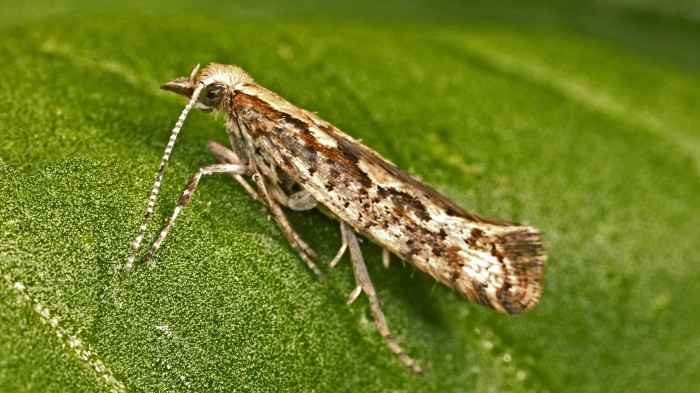Genetically Engineered Moths Coming to a Cabbage Patch Near You

A proposal by Cornell University to release genetically engineered moths with a gene that causes them to eventually die off has been approved for a small area in upstate New York by the U.S. Department of Agriculture.
Researchers say the engineered insects could be a pesticide-free tool in fighting crop damage caused by the diamondback moth, an invasive species known to destroy cabbage, cauliflower, and broccoli. The federal agency is giving a green light to the experiment because it says the field trial is unlikely to pose a risk to the environment or human health.
Since the 1950s, scientists have been creating sterile insects by exposing them to radiation to help reduce pest populations on farms. But if this experiment moves forward, it will be the first open-air release of genetically modified insects created with a technology other than radiation for agriculture in the U.S.
The moth trial signals a growing interest—and anxiety—around more widespread use of genetic modification in agriculture, as academic and commercial researchers move from using the technology on plants to insects.
U.K. company Oxitec, owned by biotechnology conglomerate Intrexon, is the maker of the moths. The company has designed male diamondback moths to have what it calls a “self-limiting gene.” When the males mate with females, the gene is passed on to the offspring. The gene makes female offspring die before they reach adulthood so they can’t reproduce. The idea is to shrink the population of moths in the area where the insects are released. The moths are also engineered to have a fluorescent protein marker used to track and monitor them.
The caterpillars—not adult moths—cause crop damage, so Oxitec says releasing adult male moths should not cause further crop losses.
Oxitec uses the same technology to create male Aedes aegypti mosquitoes, which it developed to prevent the spread of certain mosquito-borne diseases like Zika, chikungunya, and yellow fever (see “Inside the Mosquito Factory That Could Stop Dengue and Zika”).
Anthony Shelton, an entomologist at Cornell University who is leading the experiment, says the field trial is needed to get additional information on how these insects could be used for pest management in the future.
Shelton and his team will release the genetically engineered moths in a 10-acre field owned by Cornell University in Geneva, New York. The federal permit allows for up to 10,000 male genetically engineered moths to be released at a time, or up to 30,000 moths per week, over the span of three to four months.
According to Shelton, studies in cages and greenhouses have shown that the engineered moths are effective at reducing the population of the insects. But local and national groups who oppose the open-field release point out that these results have not yet been published in a peer-reviewed journal.
Jaydee Hanson, a senior policy analyst at the Washington, D.C.-based Center for Food Safety, says the consumer advocacy organization is also concerned that the use of the GE moths won’t reduce pesticide use. “There are other insects that eat these vegetables. If you will still have to spray the same chemicals to kill other pests, where’s the advantage in this?” Hanson says.
The New York State Department of Environmental Conservation still needs to approve the experiment before the trial can start.
In 2015, the USDA issued Shelton a permit for a similar field trial. But the agency withdrew the permit because it had not formally notified the public of its environmental assessment, which was a finding of “no significant impact” to the environment and human health.
Last year, federal regulators approved the open-air release of Oxitec’s genetically modified mosquitoes. That release has been delayed. Oxitec has already released the engineered mosquitoes in parts of Brazil, Grand Cayman, and Panama, and says it has led to declines in Aedes aegypti mosquito populations in those areas.
Keep Reading
Most Popular
Large language models can do jaw-dropping things. But nobody knows exactly why.
And that's a problem. Figuring it out is one of the biggest scientific puzzles of our time and a crucial step towards controlling more powerful future models.
The problem with plug-in hybrids? Their drivers.
Plug-in hybrids are often sold as a transition to EVs, but new data from Europe shows we’re still underestimating the emissions they produce.
Google DeepMind’s new generative model makes Super Mario–like games from scratch
Genie learns how to control games by watching hours and hours of video. It could help train next-gen robots too.
How scientists traced a mysterious covid case back to six toilets
When wastewater surveillance turns into a hunt for a single infected individual, the ethics get tricky.
Stay connected
Get the latest updates from
MIT Technology Review
Discover special offers, top stories, upcoming events, and more.